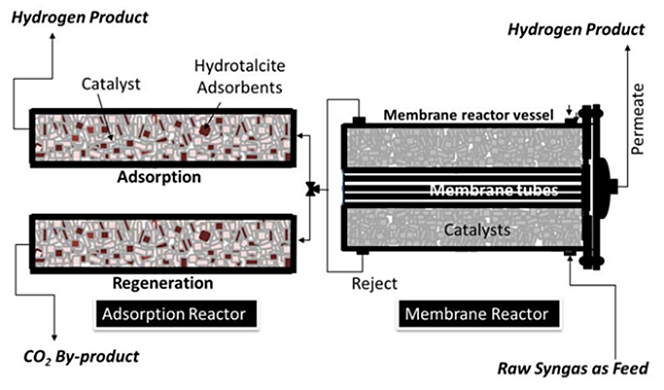The University of Southern California has teamed with Media and Process Technology Inc. to perform laboratory-scale testing of a high-efficiency, low-temperature reactor process for the water gas shift (WGS) reaction of coal syngas for pre-combustion carbon dioxide (CO2) capture in integrated gasification combined cycle (IGCC) systems. The process will utilize a unique membrane- and adsorption-enhanced WGS reactor system previously developed for hydrogen (H2) production via methane steam reforming that allows for in situ preferential H2 permeation and simultaneous CO2 adsorption. The system combines a membrane reactor (MR) and an adsorptive reactor (AR) in tandem to produce an ultra-pure H2 product continuously until the adsorbent (in the AR unit) is saturated, which is then regenerated via a temperature swing adsorption (TSA) operation. This unique reactor configuration can be viewed as a hybrid MR-AR system under TSA operation. The MR-AR system is a highly-efficient and ultra-compact process for the treatment of syngas to produce hydrogen appropriate for use in IGCC with simultaneous pre-combustion CO2 capture. Further the use of a temperature-swing rather than a pressure-swing CO2 recovery step (as commonly practiced in AR systems) allows the recovery of CO2 at high pressures, thus requiring no additional re-compression step for CO2 storage. The project goal is to validate the novel hybrid MR-AR system for IGCC applications by conducting laboratory-scale studies using simulated coal-derived syngas. The development effort will use a previously developed carbon molecular-sieve-based membrane and will test a hydrotalcite-based adsorbent and other potentially promising adsorbents. A mathematical model will be used to analyze the resulting data, further optimize the system, develop preliminary technical designs, and conduct a techno-economic analysis.
Presentations_plp
- A High Efficiency, Ultra-Compact Process for Pre-Combustion CO2 Capture [PDF] (Aug 2017)
Presented by Vasilios Manousiouthakis, University of Southern California, 2017 NETL CO2 Capture Technology Project Review Meeting, Pittsburgh, PA
- A High Efficiency, Ultra-Compact Process For Pre-Combustion CO2 Capture [PDF] (Aug 2016)
Theodore Tsotsis, University of Southern California, BP1 Review Presentation
- A High Efficiency, Ultra-Compact Process for Pre-Combustion CO2 Capture [PDF] (Aug 2016)
Presented by Theodore Tsotsis, University of Southern California, 2016 NETL CO2 Capture Technology Project Review Meeting, Pittsburgh, PA
- A High Efficiency, Ultra-Compact Process for Pre-Combustion CO2 Capture [PDF] (Nov 2015)
Project kick off meeting presentation
Principal Investigator
Theodore Tsotsis
tsotsis@usc.edu
Project Benefits
The hybrid concept process allows the simultaneous removal of both H2 and CO2, which results in significant reaction rate enhancement over the conventional WGS system. Validation of the hybrid process with simulated coal-derived syngas will confirm its readiness for fully-integrated testing with actual coal-derived syngas, charting a pathway toward meeting the overall DOE performance goals of a 90 percent CO2 capture rate with 95 percent CO2 purity at a cost of electricity of 30 percent less than baseline capture approaches.
Website
University of Southern California
http://www.usc.edu/




